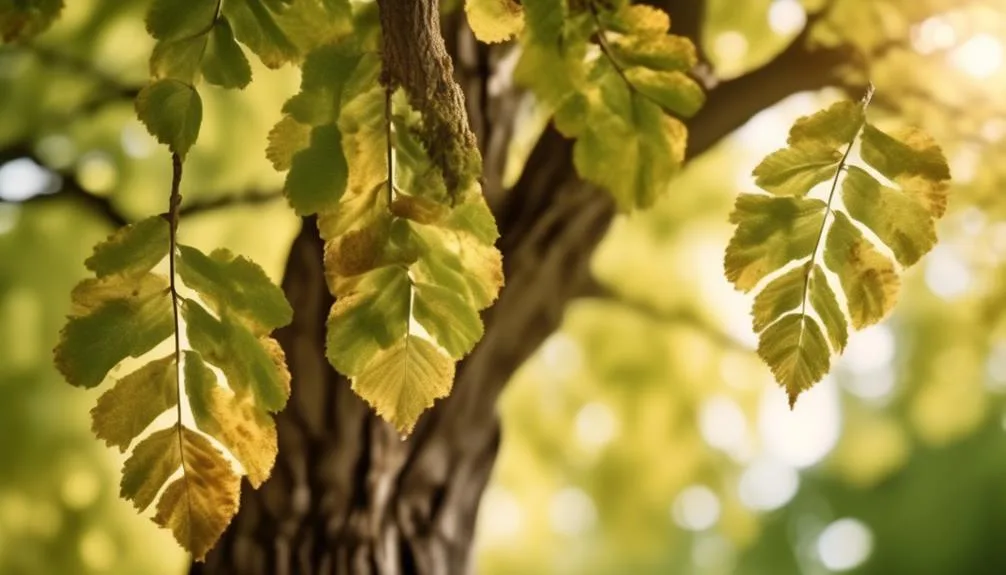Elm trees, like resilient survivors in a storm, face the challenge of leaf scorch. Can they recover? It's not a simple answer. Understanding how elm trees bounce back from leaf scorch is crucial.
From recognizing signs of recovery to best practices, there's a lot to consider. Let's explore how these majestic trees can overcome leaf scorch and thrive again.
Understanding Elm Leaf Scorch
To understand Elm Leaf Scorch, observe the symptoms and identify potential causes for this condition.
Symptoms of Elm Leaf Scorch include wilting, yellowing, and browning of the leaves, especially around the edges.
Prevention is crucial and involves proper watering, mulching, and regular tree maintenance.
Causes of Elm Leaf Scorch can be attributed to environmental stress, such as drought or compacted soil, as well as various diseases and pests.
It's important to address these underlying issues to prevent further damage to the tree.
Treatment options for Elm Leaf Scorch may include adjusting watering practices, improving soil conditions, and addressing any pest or disease problems.
With proper care and attention, Elm trees affected by Leaf Scorch can recover and thrive once again, adding beauty to the environment.
Signs of Recovery in Elm Trees
Recovery signs in Elm trees become apparent as new growth emerges and the leaves regain their vibrant green color. After undergoing leaf scorch, observe the growth patterns closely.
New shoots and leaves sprouting from the branches are a positive indication of recovery. The emergence of healthy, green foliage signals that the tree is rebounding from the stressful environmental conditions it faced.
Keep an eye on the overall appearance of the tree – if the new growth is consistent and widespread, it's a good sign. Factors such as proper watering, nutrient levels, and favorable weather can contribute to the recovery process.
As the tree continues to grow and flourish, it's essential to maintain a suitable environment to support its ongoing recovery.
Factors Affecting Elm Tree Recovery
After observing the signs of recovery in elm trees, it's important to understand the various factors that can impact their ability to bounce back from leaf scorch and thrive once again.
- Environmental Factors
- Soil quality and moisture levels
- Sunlight exposure and temperature fluctuations
- Air pollution and other environmental stressors
- Management Practices
- Pruning and trimming to remove damaged areas
- Fertilization and watering techniques
- Pest and disease control measures
- Damage Prevention and Treatment
- Implementing proper watering and mulching strategies
- Applying appropriate fungicides or insecticides
- Regular monitoring and prompt action against potential threats
Considering these factors, it becomes clear that a holistic approach to environmental care, effective management, and proactive damage prevention and treatment are essential for promoting elm tree recovery.
Best Practices for Supporting Elm Tree Recovery
Supporting the recovery of elm trees requires implementing specific best practices that address environmental care, management, and damage prevention.
Nutrient supplementation is essential for elm tree recovery. Consider using a slow-release fertilizer high in nitrogen, which supports new growth and overall tree health.
Watering techniques are crucial during the recovery process. Ensure that the soil around the tree remains consistently moist, but not waterlogged, to support root regeneration and overall hydration. Deep, infrequent watering is preferable to shallow, frequent watering.
Additionally, consider mulching around the base of the tree to help retain soil moisture.
Proper care and attention to these best practices will aid in the recovery of elm trees affected by leaf scorch, promoting their overall health and vitality.
Timeline for Elm Tree Recovery
As your elm tree begins its recovery journey, understanding the timeline for its restoration is crucial to providing the right care at the right time. Here's a breakdown of the recovery timeline to guide you through the process:
- Initial Recovery (0-6 months)
- Focus on providing adequate water and nutrients to support new growth.
- Monitor the tree for any signs of stress or disease and address them promptly.
- Mid-term Recovery (6-12 months)
- Implement appropriate pruning techniques to remove dead or damaged branches.
- Continue to maintain a consistent watering schedule to support the tree's overall health.
- Long-term Recovery (12+ months)
- Gradually reduce the frequency of watering as the tree becomes more established.
- Evaluate the overall health of the tree and adjust care practices as needed.
Conclusion
With proper care and attention, elm trees have the potential to recover from leaf scorch. Understanding the signs of recovery, considering influencing factors, and implementing best practices can help your elm tree bounce back.
Patience and care are key for your elm tree to thrive once again.

My interest in trees started when I first saw the giant sequoias in Yosemite.
I was a teenager then, and I remember thinking, “I need to learn more about this.”
That moment stuck with me.
A few years later, I went on to study forestry at Michigan Tech.
Since graduating, I’ve worked in a mix of hands-on tree care and community education.
I’ve spent over ten years helping people understand how to plant, maintain, and protect the trees in their neighborhoods.
I don’t see trees as just part of the landscape.
They are living things that make a real difference in our daily lives.
